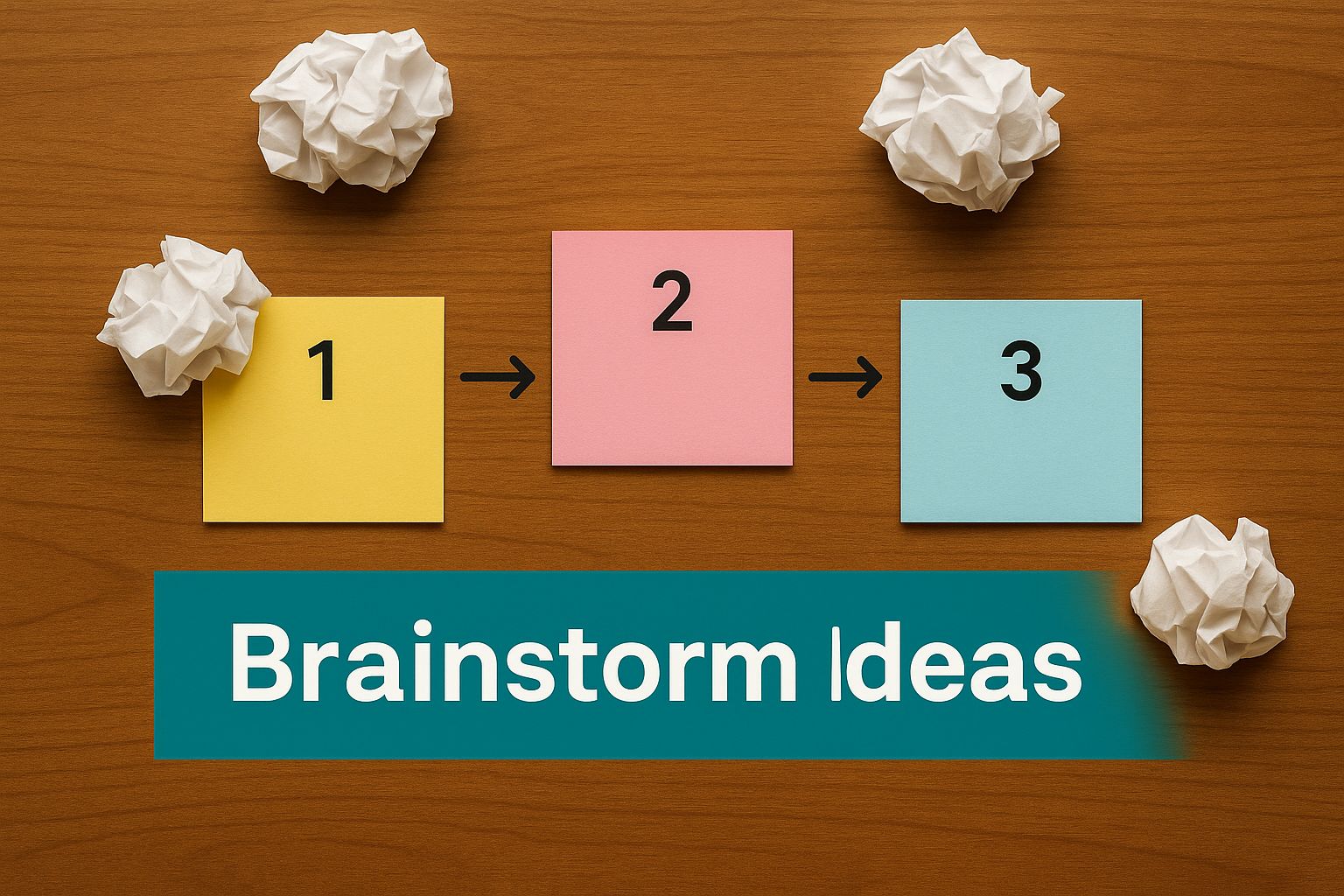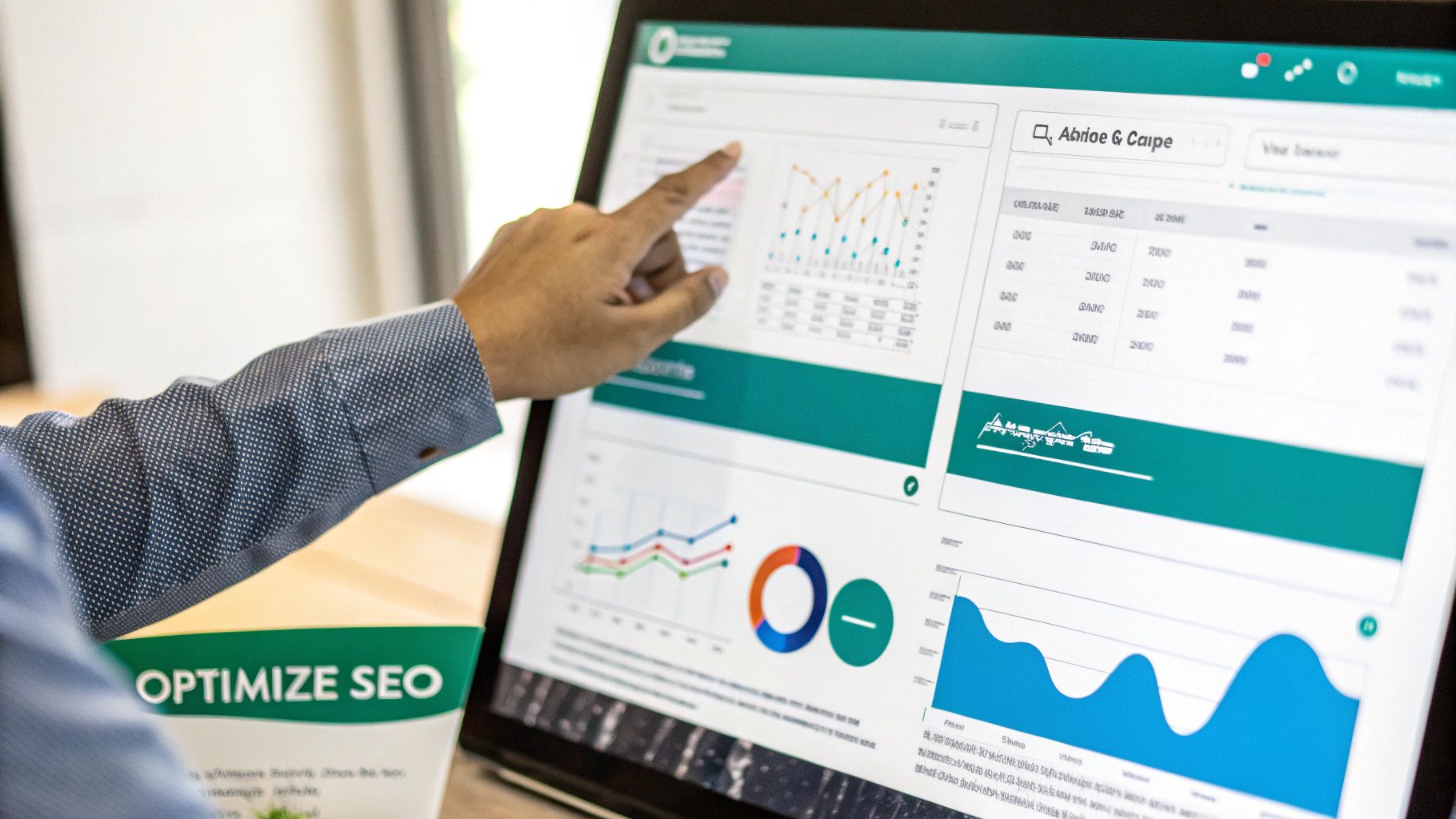To craft a title that truly grabs attention, you have to do more than just describe your content. You need to blend a clear, tangible benefit for the reader with an emotional hook. It’s not just about what your content is, but what it does for them. This combination is what separates a title that gets clicks from one that gets scrolled past.
Your Title Is Your Most Valuable Real Estate

Think of your title as the single most critical piece of your content. Seriously. It’s the gatekeeper, the first handshake, and often your only shot at convincing someone that your article, video, or guide is worth their precious time. A well-crafted headline directly influences everything from click-through rates (CTR) to how long people stick around.
The best content creators I know get this. They don't just write summaries; they make a promise. Your title's job is to signal undeniable value to both search engines and, more importantly, human readers. That’s why I always say that spending time on your title is the highest-leverage activity in the entire content creation process.
The Psychology Behind a Click
So what makes a title irresistible? It’s not magic. It's a bit of psychology, usually a mix of three powerful elements:
- Curiosity: It opens a little loop in the reader's mind. They suddenly feel a need to find out what's on the other side of the click.
- Benefit: It immediately answers the reader's unspoken question: "What's in it for me?" It promises a solution, an improvement, or some kind of gain.
- Specificity: Using numbers, data, or concrete details makes your promise feel more real and credible. It tells the reader exactly what to expect.
When you nail this combination, you're not just labeling your work. You're engineering a compelling call to action that's hard to ignore.
Your title isn't just a preview of your content; it's a promise of the value inside. Break that promise, and you lose trust. Fulfill it, and you might just earn a loyal reader.
Why Titles Matter Even More in a Tough Economy
This intense focus on delivering clear value is especially important when things are uncertain. For example, the United Nations projects that global economic growth will slow to just 2.4% in 2025, thanks to ongoing trade tensions and policy changes.
In that kind of environment, businesses and consumers alike are more careful with every decision they make—including what content they choose to consume. Your title has to work harder than ever to prove its worth from the very first glance. You can read more on these economic trends and how they're impacting people worldwide.
Setting the Stage for a Title That Clicks
Look, a great title doesn't just happen. It’s not some stroke of creative genius that hits you in the middle of the night. It's built on a solid foundation of research. Before you even think about stringing words together, you have to get inside your audience's head and scope out the competition. This prep work is the difference between a title that truly performs and one that just takes up space.
It all starts with keyword research, but not the old-school way of just grabbing the highest-volume term. You need to dig deeper into user intent. What is someone actually trying to accomplish with their search? Are they looking for a quick fix? A deep dive into a topic? A side-by-side comparison? Your title has to promise exactly what they're after.
Become a SERP Detective
Got your target keyword? Good. Now, go plug it into Google and see what shows up on the first page. This isn't about stealing ideas; it's about recognizing what's already working. You're looking for patterns.
For instance, if you search for "SEO title tags," you'll probably see a lot of listicles and "how-to" articles dominating the results.
What does this tell you? It shows that people searching for that term want actionable tips, not a dry, academic definition. To even compete, your title needs to signal that you're offering a practical, step-by-step solution. This kind of analysis is how you find the gaps you can fill and the emotional hooks that are already resonating with searchers.
A great title speaks directly to a user's pain point using the language they already use. Your research phase is where you discover that language.
This groundwork is more important than ever. The World Bank's full report forecasts a sluggish global GDP growth of just 2.3% for 2025. In a tough economy, people—both consumers and businesses—are incredibly picky about where they spend their time and money. Your title has to work harder than ever to prove its value and earn that click.
Tap Into Proven Formulas for Titles That Just Work
Enough with the theory—let's get practical. You don't have to reinvent the wheel every time you sit down to write a headline. The pros don't. Instead, we rely on a toolkit of proven formulas that take the guesswork out of the process. These frameworks are effective because they tap directly into human psychology.
A classic starting point is the benefit-driven formula. This approach gets right to the heart of what every reader is thinking: "What's in it for me?"
Think about it. A title like "Gardening Tips" is okay, but it's generic. Now, consider this: "Grow Twice the Tomatoes in Half the Space." See the difference? The second one promises a tangible, highly desirable result. That’s what gets the click.
Of course, a great title rarely appears in a flash of genius. It's usually the result of some messy, creative brainstorming.

The image above is a perfect metaphor for the process: you start with a jumble of ideas and slowly refine them until you land on something powerful.
A Few Go-To Title Frameworks
Beyond just highlighting a benefit, several other structures are incredibly reliable. Each one serves a slightly different purpose and appeals to a unique reader motivation.
One of my favorites is the Intriguing Question. A title like, "Are You Making These Common Financial Mistakes?" creates an instant curiosity gap. People can't help but click to find out if they're on the list. It feels personal and urgent.
Another workhorse is the Specific How-To. Titles like "How to Change a Tire in Under 10 Minutes" work so well because they promise a clear solution to a specific problem. That added detail—"under 10 minutes"—lends it credibility and makes the value proposition much stronger.
The best title formulas aren't just templates; they are psychological shortcuts. They connect your content directly to a reader’s needs, curiosities, or fears, making the click feel like a natural next step.
Here are a few more tried-and-true formulas you can adapt for your own content:
- The Listicle: "7 Ways to Improve Your Public Speaking Today." This format is a perennial winner because it sets clear expectations. The reader knows they're getting a scannable list of actionable tips.
- The Big Reveal: "The One Thing Top CEOs Do Before 8 AM." This style creates a sense of insider knowledge and exclusivity. It’s hard to resist finding out the "secret."
- Bracketed Clarifiers: "How to Write a Resume [Free Template Included]." The brackets act like a visual magnet, drawing the eye and highlighting an immediate, tangible resource. This simple addition can significantly boost the perceived value of your content.
Choosing the right formula really depends on your article and your audience. The goal is always the same: pick a structure that accurately reflects your content's value while sparking just enough interest to earn that all-important click.
Weaving Keywords into Your Titles Naturally

When you write a title, you're trying to win over two very different audiences: real people looking for answers and the search engine algorithms that rank your content. The secret to a great title is making both happy at the same time. This means your keywords need to feel like they belong—not like they were shoehorned in.
A simple but powerful trick is to front-load your main keyword. Get it as close to the beginning of the title as you can. This is the fastest way to signal relevance to both Google and someone quickly scanning the search results. For instance, "SEO Title Best Practices" is much more direct and effective than "A Guide to Best Practices for Your SEO Title."
But don't stop with just one keyword. Think about related terms and synonyms that give search engines more context. If your core keyword is "SEO title," you could strengthen your headline by also including words like "headline tips," "writing guide," or "click-through rate." It paints a much fuller picture of what your article covers.
Beyond Keywords: The Technical Details
Getting the words right is a huge part of the puzzle, but some technical details can make or break your title's success on the search engine results page (SERP).
The most common mistake I see is ignoring pixel width. Google doesn't count characters; it measures the physical space your title takes up. If it's too wide, it gets cut off with an ellipsis (…), which can absolutely tank your click-through rate. Always use a SERP preview tool to see exactly how your title will appear on both desktop and mobile before you hit publish.
This level of detail is more important than ever. As competition stiffens and budgets get tighter, every single click counts. With global economic growth predicted to slow to just 2.3% in 2025, you can't afford to waste opportunities. Optimizing every element, including your title, is how you gain an edge. You can read more about how these global economic pressures are reshaping strategies in this UNCTAD report.
Finally, give your keyword-optimized title an extra boost with elements that grab human attention. Think numbers, dates, and even brackets. They work wonders for making your title pop.
- Numbers: "10 Tips for an SEO Title That Gets Clicks"
- Dates: "How to Write SEO Titles in 2025"
- Brackets: "Writing SEO Titles [A Step-by-Step Guide]"
These additions aren't just for show; they break up the visual monotony of the search results and give people a compelling reason to choose your content over the others.
Testing and Refining Titles for Peak Performance
https://www.youtube.com/embed/hzNRuCxxKlA
Let’s be honest: your first title idea is rarely your best. I’ve been doing this for years, and my initial drafts are often just a starting point. The real magic happens when you stop guessing and start testing. Data is what separates a good title from a great one, and thankfully, you don't need a huge budget to get the data you need.
There are some surprisingly simple ways to get feedback. For instance, you can run a quick poll on social media. Just post two of your best headline ideas and ask your audience which one they’d be more likely to click. It’s a fast, free way to see what resonates.
Another one of my favorite low-effort tactics is to test titles as email subject lines. Split your email list in half, send each group a different subject line, and see which one gets more opens. The winner is often a solid bet for your final article title.
From Social Tests to Search Console
If you have a small ad budget, even a few dollars on Facebook or LinkedIn can give you incredibly valuable insights. Set up two identical ads where the only difference is the headline. The version that earns more clicks is your data-backed winner, and you've validated it with a cold audience, not just your existing followers.
The most valuable feedback comes from real user behavior. A click is a vote, and tracking those votes is the key to creating titles that consistently perform.
Once your article is published, the work isn't quite done. This is where Google Search Console (GSC) becomes your best friend. Keep an eye on the click-through rates (CTR) for your pages.
See an article with a ton of impressions but a disappointingly low CTR? The title is almost always the weak link. Swapping it out for a better one is one of the quickest SEO wins you can get. Armed with this data, you can confidently tweak your titles, refresh older content, and watch your traffic grow.
Answering Your Lingering Title Questions
Even after you've nailed down your keywords and have a few ideas, some practical questions always seem to surface. It happens to everyone. Let's walk through some of the most common sticking points I see so you can finalize your titles with complete confidence.
How Long Should My SEO Title Really Be?
This is a classic question, and the answer isn't about a specific number of characters. It's all about pixel width. Google only gives you so much space on the search results page—about 600 pixels, to be precise.
Think about it: a "W" is much wider than an "i". That’s why a 60-character title might fit perfectly, while another gets awkwardly cut off with a "…" This is why I always, always run my final title through a SERP preview tool. It’s the only way to see exactly how your title will look on both desktop and mobile, ensuring your full message comes through loud and clear.
Should I Squeeze My Brand Name In?
This one truly depends on your brand's reputation. If you've built a name that people already know and trust, like Moz or HubSpot, adding it at the end of your title can be a smart move. It acts as a stamp of authority and can absolutely boost your click-through rate. A title like "10 Headline Tips – By Moz" is a perfect example of this.
On the flip side, if your brand is still getting its footing, that valuable space is much better spent on descriptive keywords. Focus on terms that will help you rank and attract the right audience first. Build the authority, then add the brand name.
Pro Tip: Don't be afraid to have a different on-page H1 heading and SEO title tag. Optimizing for both the search engine and the on-page reader is a savvy move.
Can My H1 and SEO Title Be Different?
Absolutely, and in most cases, they should be. This is a common tactic used by experienced SEOs.
Your SEO title (the title tag) is your pitch on the search results page. Its main job is to grab attention and earn the click, so it needs to be packed with the right keywords and a compelling hook.
Your H1 heading, however, is for the person who has already landed on your page. They're already here. Now you can get a bit more creative, welcome them, and reinforce the value they're about to get from your content. It’s about optimizing for two different stages of the user journey.
What's the Deal with "Power Words"?
Power words are specific terms that tap into human emotion and psychology. They’re persuasive by nature and can make your titles feel much more urgent and compelling.
Words you’ve probably seen a million times:
- Proven
- Effortless
- Ultimate
- Instant
- Essential
When you sprinkle these in thoughtfully, they can genuinely increase clicks. The key is authenticity. If you stuff your headline with them, it starts to look like cheap clickbait, which can wreck your credibility. Often, just one well-chosen power word is all it takes to make a real impact.
Ready to see how AI perceives your brand? Llamo Pro provides a fast, comprehensive audit to show you where your brand stands in the eyes of large language models. Get the insights you need to improve your digital visibility.

